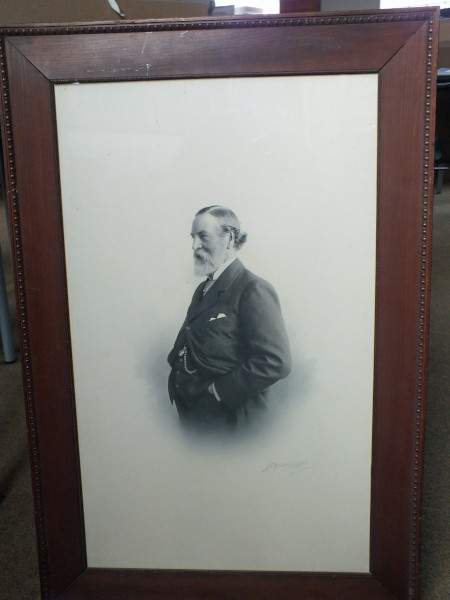Photograph Collection
>
Main Photograph Collection
>
Photographs Sorted by Waterway
>
Unknown Location/Other
BW192/3/2/6/17
Portrait photograph of Frederick Morton who was director of Fellows, Morton & Clayton Limited
Description
Black and white photograph of Frederick Morton taken on his 80th birthday 1915
Copy print taken of the original framed studio portrait by H J Whitlock & Sons.700mmx422mm.
Date
1915
Reference code
BW192/3/2/6/17
Creator
Whitlock, Henry Joseph
Administrative / Biographical history
H. J. Whitlock and Son of 11 New Street, Birmingham. Telephone: Midland 5623
◾ Henry Joseph Whitlock (c1835-1918), was the son of Joseph Whitlock (b. 1806, Olney, Buckinghamshire; d. 1857, Birmingham) and Sarah (b. c1815; d. 1862, Birmingham). [1]
◾ Joseph Whitlock was one of the earliest photographic artists in Britain and the first to establish a permanent photographic studio in Birmingham.
◾ 1842 Joseph Whitlock reportedly paid Richard Beard £1000 for a licence to take daguerreotype portraits in Warwickshire and Northamptonshire.
◾ 1843 On Monday, 30 January, Joseph Whitlock opened Birmingham's first daguerreotype studio at 120, New Street. At the same time, he opened a photographic portrait studio at the Royal Assembly Rooms in Leamington Spa. During that year, he also opened studios in Coventry, Rugby, and Warwick.
◾ 1844 In January, Whitlock opened a further studio at Northampton.
◾ 1847 Joseph Whitlock had established a photographic studio at Bromley House, Angel Row, Nottingham.
◾ 1849 and again between 1851 and 1853, the studio worked under the partnership of Whitlock and Thompson. Only the studio in Birmingham proved successful. For the first seven years or so, Joseph Whitlock held a monopoly in making photographic portraits in Birmingham.
◾ 1852 Joseph Whitlock expanded his business in Birmingham and recruited his two sons Henry Joseph (b. c1835 Olney) and Frederick (b. c1839 Olney) to assist him.
◾ 1855 Henry Joseph Whitlock left Birmingham to set up his own studio at 42 High Street, Worcester. His father, Joseph Whitlock continued to run the photographic studio in New Street, Birmingham, but he was dogged by ill health. Joseph's wife and sons became more involved in the running of the business as his health declined.
◾ 1857 Joseph Whitlock died at the end of the year, aged 51, and the Birmingham studio, now at 110 New Street, passed to his widow Mrs Sarah Whitlock.
◾ 1862 On 24 October, at the age of 47, Mrs Whitlock died at 110 New Street, Birmingham. After the death of his parents, Henry Joseph Whitlock established a studio of his own at 11 New Street Birmingham. He was assisted by his two sons Arthur (born 1865 Birmingham), and Henry junior, (Harry - born c1871 Birmingham). Whitlock remained at the same address for 30 years.
◾ Henry Joseph Whitlock's younger brother, Frederick, was also a photographer and established his own studio in New Street, Birmingham and later at Park Road, Sutton Coldfield. Frederick's two sons, Herbert (b. c1870 Birmingham) and Frederick junior (b. c1874 Birmingham) were both photographers.
◾ By the late 1860s, he was able to claim 'Photographer to the Queen' (with royal crest), although this was modified in the 1870s to 'By Special Appointment to the Queen'.
◾ c1873 By then, he had taken 34681 photos, an average of around 3,000 a year.
◾ 1881 In the census, the family had two servants: a General Domestic and a nurse.
◾ 1891 He had added 'and H.R.H. The Prince of Wales'.
◾ By 1892 he had taken 95312 photos, also about 3000 a year, and business was steady at around 40 sittings a day, giving 12 minutes for each photo during an eight hour day (not possible in winter) or about 30 minutes each if he ran two studios - which seems likely.
◾ 1901 Herbert Whitlock was working as a photographer alongside his father in Sutton Coldfield and his brother Frederick W. Whitlock was a photographer living in Oxford.
◾ 1937 Listed Exhibitor - British Industries Fair. Commercial Photographs. (Stand No. Ca.312a) [2]
◾ The firm of Whitlock continued as a photographic business in Birmingham until the mid-1960s.
◾ Henry Joseph Whitlock was associated with 65 portraits now in the National Portrait Gallery. [3]
Extent & medium
1 photograph
Physical characteristics
Framed portrait retained in original wood and glazed frame. CARE WHEN MOVING - GLASS










